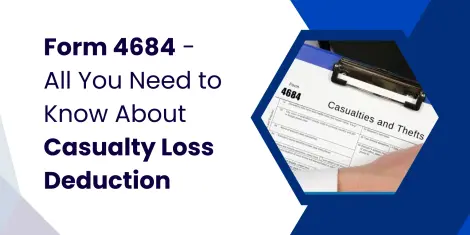Table of Contents
A tax credit allows American taxpayers to lower their overall tax bills, which is a desirable objective for people with a taxable income. The education tax credit is one of the tax credits that taxpayers earn by spending money on education. However, there is a limit to how much the education tax credit one can claim. Let us delve deeper into this topic and find out who is entitled to the education tax credit and how to claim the same!
What are education tax credits?
Education tax credits can be claimed by taxpayers paying for the higher education of a student eligible for the tax scheme. The student must be a college or a university goer. Education tax credits are the Lifetime Learning Credit and the American Opportunity Tax Credit. The LLC (Lifetime Learning Credit) is made available to students to offset the costs related to their graduate/ undergraduate or professional degree. In contrast, the latter is available to students who have just started higher education and are still working on the initial four years. A taxpayer can only claim one of these two credits and must determine which one they’re entitled to.
Who is qualified for these tax credits?
To be eligible for any of the education tax credits mentioned above, the taxpayer must meet the following requirements:
- To qualify for the education tax credit, either you or a dependent must be pursuing higher education and therefore be paying higher education expenses that qualify.
- Either you, a dependent, or your spouse must be an eligible student, and they must be listed on their tax return.
- The educational institute the student studies at must be eligible and approved by the IRS.
- For a taxpayer to receive the LLC, modified adjusted gross income must be within $80,000 if they file their taxes separately or $160,000 for married couples that file their taxes jointly.
Only a few educational expenses qualify for consideration while claiming the Qualified Higher Education Expenses (QHEE) educational tax credit. They include tuition fees, book costs, and expenses on supplies necessary for a student to attend a post-secondary institution. The QHEEs may be paid directly or indirectly to the secondary educational institution. For the students to be able to claim this credit, all schools send out Form 1098-T.
What are the types of ETC?
You can choose from two Education Tax Credits: the American Opportunity Tax Credit and the Lifetime Learning Credit. The eligibility criteria are different for both these credits, and you need to understand which one you are eligible for to receive your Education tax credits at the right time.
The AOTC (American Opportunity Tax Credit) can be received by students who are still going through their initial four years of higher education and have yet to claim the AOTC or the Hope Credit. To receive this credit, you must be a half-time student for an academic year and must not have a felony drug conviction in your name. It is also important to note that the income limit for claiming the AOTC lies at a MAGI(Modified Adjusted Gross Income) of $160,000 for couples that file their taxes jointly and $80,000 for individuals that file their taxes on their own. The AOTC allows students to claim 100% of the first $2,000 spent on their school education and a quarter of the next $2,000 spent on the same. This implies that the maximum amount a taxpayer can receive from this credit is $2,500, which can offset an educational cost of $4,000 to $1,500. The AOTC is not fully refundable, and if it reduces your tax bill to zero, the IRS will send you 40% of the remaining credits, implying that you can receive a $1,000 refund at most.
The Lifetime Learning Credit allows taxpayers to lower their educational expenses irrespective of their educational level. This Educational Credit allows learners to claim Education Credits for Undergraduate, Graduate, and Post-graduate courses as well. It also allows learners to claim expenses related to courses that can help people improve their professional prowess. You can claim 20% of the first $10,000 of your educational expenses, or up to $2,000 per tax return on this Educational Credit. If your Maximum Aggregated Gross Income is below $80,000 you will be able to claim the maximum credits. However, a MAGI between $8,000-$9,000 will diminish the tax credits you can claim. The LLC is not refundable. This implies that if claiming the LLC lowers your tax bills to zero, you won't be able to get a refund of the remaining tax credits you are entitled to.
Calculating the amount of refunds you are entitled to can get quite hectic if you pay your educational expenses and have other expenses that need to be considered while you file your tax returns. It is therefore suggested that you source help from tax professionals who are well acquainted with methods of maximizing your tax returns. This is where NSKT Globals comes into play. You can connect your bank accounts with your NSKT Global account which automatically detects all the expenses that can be leveraged to lower your tax returns. You can log on to the official NSKT Global website, and find out how you can benefit from the services offered by well-trained, and dedicated tax experts. Book a free appointment with one of our representatives, right now!
FAQs
1. Is the AOTC different from the LLC regarding the educational degrees you might be pursuing?
The American Opportunity Tax Credit, or the AOTC, only allows you to claim tax credits for the educational expenses you incur during your first four years of higher education, while the Lifetime Learning Credit (LLC) allows you to claim educational expenses spent on education throughout your life.
2. Can you claim both AOTC and LLC at the same time?
No, you can claim any one of them at a time.
3. How much can you claim on both of these taxes?
You can claim $2,500 on the AOTC and $2,000 at max on LLC.
4.Is the AOTC refundable?
Yes, the AOTC is refundable. If the AOTC has brought your tax bills to zero, and there is still some tax credit remaining, you will get a refund of 40% of the remaining tax credits.
5.What is the income limit for taxpayers to receive this tax credit?
If you are single or file your taxes separately, you are eligible for the full tax credit if your Modified Adjusted Gross Income is below $80,000 or $160,000 if you file your taxes jointly with your spouse.
6. What does one mean by MAGI?
MAGI or Modified Adjusted Gross Income, is obtained by adding back foreign earned income, excluding, excluding and deducting for foreign housing and some other incomes to the AGI reported by a taxpayer on line 11 of Form 1040 or Form 1040-SR.







